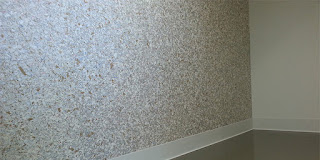Last month we blogged about the eco-friendly drywall options available. As you probably remember there really wasn't (to our knowledge at the time) a viable eco-friendly drywall option available on U.S. market. Well, thankfully we were happily wrong! Our new friends at The ReWall Company in Des Moines, IA are producing two eco-friendly drywall replacement options that are not only viable, but in many ways are far superior to traditional drywall. I'm sure you probably also remember from our previous blog that traditional drywall is a big ouch for our environment. The manufacturing of drywall ranks as the third highest green house gas producer for building materials. ReWall's ground breaking drywall replacement products are called NakedBoard and EssentialBoard
ReWall EssentialBoard is a structural rated panel product made of 100% recycled material derived from milk cartons and other beverage containers and cups. The content is shredded and compressed, giving the user a sustainable and superior performing panel. The ReWall EssentialBoard is made of a water resistant core and surfaced with paper facing on both sides. ReWall NakedBoard is a prefinished interior wallboard made of 100% recycled material derived from milk cartons and other beverage containers and cups. It is a durable, moisture-resistance sustainable solution made of a polycoated paper waste without a facing material. The shreds of recycled paper are left exposed, creating an exclusive design that says “recycled” at first glance. For more information about ReWall's products please visit www.rewall.com
If the world massively converted it's drywall usage to eco-friendly products like EssentialBoard and NakedBoard we would take a nice sized step in improving our environment. Eco-friendly replacement products made from 100% recycled materials offer a double positive impact to our environment. First, the high level of green house gases produced during the manufacturing of drywall are eliminated. And second, the recycled content avoids being added to a U.S. landfill. These are likely the types of changes that will be needed to combat climate change, big thank you to The Rewall Company for making it an actual possibility! Please check back at paperplaneco.us for Rewall products available in South Florida.



















